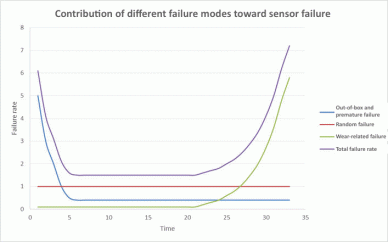
Electronic pressure sensors can stop working for a variety of reasons. Understanding those reasons is a key step in preventing future failures.
A pressure sensor plays a key role in the instrumentation of machinery and processes. When sensors fail, the process often fails, sometimes with costly or even catastrophic consequences. That leads to the obvious question of why some pressure sensors fail while others do not.
Five Categories of Pressure Sensor Failure
When sensors stop working in the field, the reasons fall into five broad categories:
1. Out-of-box failure
Pressure sensors can fail before they’re even commissioned due to faulty materials, poor workmanship, or both. Those incidents, often referred to as DOA (dead on arrival), OOB (out of box) failure, or zero miles failures, are very rare, as any reputable manufacturer has quality control systems in place to prevent manufacturing defects.
Moreover, as pressure sensor production requires several steps, such as assembly and calibration, most issues are caught at the component or sub-assembly level before even getting to the final inspection stage. Testing is another important step of the manufacturing process. Products passing the final inspection but failing during transit should occur only at a single-digit dpm (defects per million) rate.
2. Premature failure
Pressure sensors that fail during the warranty period, typically 12 to 24 months, are typically caused by faulty materials or poor workmanship.The more complex the sensor design, the greater its odds of premature failure. The number of incidents during the warranty period can be 100 to 1,000 dpm.
Products failing during the warranty period (typically 12-24 months) are also considered faults caused by faulty materials or poor workmanship. Depending on the complexity of a product, the number of incidents during a 1- 2 year interval range from 100 dpm to 1,000 dpm. The premature failure rate is related to the product’s complexity (number of components and process steps in the manufacturing process) and the manufacturer’s ability to control manufacturing processes. As a rule of thumb, the failure rate is correlated with the number of components, connections, and functions:
- Passive, mass-manufactured sensors achieve dpm rates in the single digit to low double digit range.
- Conventional (analog) pressure sensors in serial production achieve dpm rates in the low hundreds range.
- More complex instruments like smart transmitters, with digital circuitry, microprocessors, and displays, have a premature failure rate of around 1,000 dpm.
3. Random failure
If a pressure sensor stops working after the warranty period, the so-called “random failure rate” applies. This rate can be expressed as the MTTF (mean time to failure) in months or years, and is directly related to the design of the product (number and complexity of the components, applied stress level).
MTTF is a statistical parameter used to compare different designs with regard to the expected random failure rate during the useful lifespan. So, a MTTF of 100 years does not mean that the product will last 100 years; rather, if you have 100 units of this product operating under the same conditions, you can expect one of them to fail per year due to random component failure.
The MTTF of pressure sensors is typically several hundred years.
4. Wear-related failure
Wear and tear is a factor in the failure of mechanical instruments. As electronic pressure sensors do not contain any moving parts, they are not subject to wear and tear per se. A quality pressure sensor can last millions of load cycles without any significant signs of aging or drift. For example, both our A-10 pressure transmitter and S-20 superior pressure transmitter have a service life of 10 million or 100 million load cycles, depending on the measuring range. This translates to a typical product lifespan of five to 15 years before wearing out.
5. Damage-related failure
The final cause of pressure sensor failure is some type of damage. Like the common reasons for pressure gauge failure, a pressure sensor could stop working due to unpredictable factors like:
- Mechanical damage
- Abuse or mishandling
- Electrical overload, like lightning or misconnection during inspection or repair work
- Pressure overload and pressure spikes
- Ingress of water/moisture or chemicals
Figure 1 shows the three predictable failure modes that lead to pressure sensor damage.
- OOO failure and premature failure are grouped together and shown as the blue line: high at the start of the sensor’s service life, dropping to near zero, then holding steady.
- Random failure (red line) is covered by the MTTF value and remains constant over time.
- Wear-related failure (green line) begins at zero, of course, and stays there until nearing the end of the sensor’s service life, when it steadily increases.
When these three failure modes are combined, the resulting curve (purple line) is in a bathtub shape.
Preventing Pressure Sensor Failure: Choosing Wisely
It may appear that there’s not much that end users can do to prevent OOO or premature failures, as the fault lies with the manufacturer. However, you can avoid these types of failures by choosing high-quality sensors from reputable suppliers with stringent quality control and extensive testing. Also, choosing a quality sensor will ensure that it can tolerate millions of load cycles before wearing out.
In addition, using the right pressure sensor for the job – including one with a suitable NEMA rating or IP rating – reduces the chances that it will be damaged by overpressure or moisture.
WIKA is a global leader in manufacturing For expert advice in choosing the right pressure sensors for your particular application, contact our product specialists.
Products mentioned in this article:
• A-10 pressure transmitter
• S-20 superior pressure transmitter


